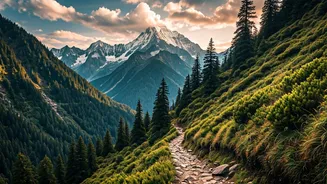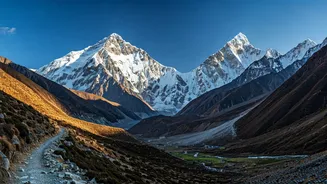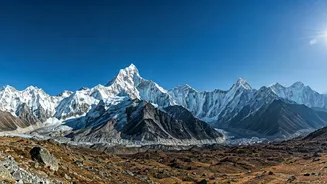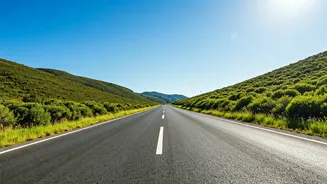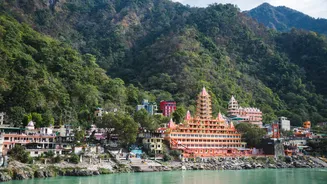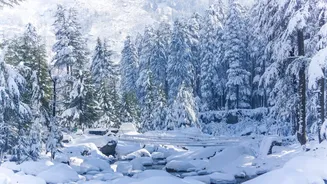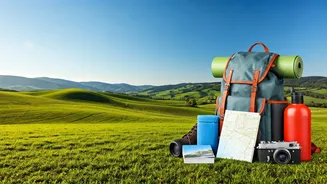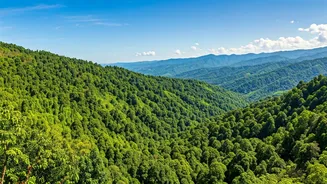Trekking in India
India, with its vast and varied topography, is a paradise for trekkers. From the rugged Himalayas in the north to the serene Western Ghats in the south,
the country boasts an incredible range of trekking destinations. These treks offer experiences for all skill levels, from gentle walks to challenging climbs. They showcase India's rich biodiversity, cultural heritage, and stunning natural beauty. Planning a trek involves considering factors like the difficulty level, the best time to visit, and essential gear. Some treks are accessible year-round, while others are best undertaken during specific seasons due to weather conditions. Careful preparation, including physical fitness training and research on the route, ensures a safe and enjoyable trekking experience. Every trek presents a unique opportunity to connect with nature and experience the breathtaking landscapes of India.
Roopkund Trek, Uttarakhand
The Roopkund trek in Uttarakhand is famous for its mysterious lake, which contains skeletal remains. The trek offers stunning views of the Himalayas and passes through diverse landscapes, including dense forests and alpine meadows. The Roopkund trek is generally considered moderate to difficult, requiring a good level of fitness. The best time to undertake this trek is during the summer months, from May to October, when the weather is favorable. Trekkers should be prepared for varying weather conditions and high altitudes. The trek usually takes around 7-9 days to complete. Highlights include the picturesque campsites, the vibrant flora and fauna, and the panoramic views of the Trishul massif. It's a journey filled with both natural beauty and an intriguing mystery. Adequate acclimatization is crucial before attempting the higher altitudes.
Hampta Pass, Himachal Pradesh
The Hampta Pass trek in Himachal Pradesh is known for its dramatic landscapes and diverse experiences. The trek spans from the lush green Kullu Valley to the arid landscapes of Lahaul and Spiti. It's considered a moderate trek, suitable for those with some trekking experience. The best time to do this trek is from June to October, when the weather is clear. The trek offers a unique opportunity to witness the stark contrast between the two valleys. The journey typically takes about 4-5 days, with highlights including the stunning views of the snow-capped peaks and the chance to camp near the serene Chandratal Lake. This trek is also popular because of its relatively shorter duration compared to other Himalayan treks. Participants should be prepared for rapid changes in weather and temperature.
Chadra Tal Trek, Himachal
The Chandra Tal trek, also located in Himachal Pradesh, is famous for its beautiful crescent-shaped lake, Chandratal. This trek offers a stunning experience of the Spiti Valley’s high-altitude landscapes. It’s categorized as a moderate trek, accessible to those with a basic fitness level and trekking experience. The optimal time to undertake this trek is from June to September. The trek usually takes around 5-6 days, offering views of the barren mountains and the pristine lake. The Chandratal is an alpine lake that reflects the surrounding mountains, providing spectacular photo opportunities. Proper acclimatization is key due to the altitude. Camp overnight near the lake to enjoy the beauty under a starlit sky. The trek offers a combination of natural beauty, adventure and tranquility.
Valley of Flowers, Uttarakhand
The Valley of Flowers trek, situated in Uttarakhand, is renowned for its vibrant meadows filled with various flowers, and is a UNESCO World Heritage site. This trek provides a relatively easier experience compared to other Himalayan treks. The best time to visit the valley is from July to September when the flowers are in full bloom. The trek usually spans around 6-7 days. Highlights include the stunning display of diverse flora and fauna, the Hemkund Sahib Gurudwara and the views of the surrounding snow-capped mountains. The valley is known for its high-altitude meadows and its rich biodiversity. Trekkers should be prepared for a moderate level of physical activity. The trek is ideal for nature lovers and those seeking a less challenging, yet equally beautiful, trekking experience.
Triund Trek, Himachal
The Triund trek in Himachal Pradesh is a popular choice for beginners and experienced trekkers alike, offering panoramic views of the Dhauladhar ranges. This trek is considered an easy to moderate one, making it accessible to a wide range of people. The best time to do the trek is from March to December, when the weather is generally clear. It usually takes a day or two to reach Triund. The highlight of the trek is the stunning 360-degree view from the top, including views of the Dhauladhar range and the Kangra Valley. It is an excellent option for those seeking a quick and rewarding trekking experience without significant physical demands. Trekkers can choose to camp overnight at Triund to enjoy the sunrise and sunset views, adding a memorable element to their adventure.
Goechala Trek, Sikkim
The Goechala trek in Sikkim is a challenging but rewarding trek that offers stunning views of Kanchenjunga, the world's third-highest peak. This trek is considered challenging and is suitable for experienced trekkers. The ideal time to undertake this trek is from April to May and September to October. The trek usually spans over 10-11 days. The Goechala trek takes you through diverse landscapes, including lush forests, alpine meadows, and high-altitude passes. Highlights include the panoramic views of Kanchenjunga, the beautiful Samiti Lake and the varied flora and fauna found along the way. Trekkers must be prepared for the high altitude and varying weather conditions. Physical fitness and acclimatization are key for a successful Goechala trek.
Kashmir Great Lakes
The Kashmir Great Lakes trek is a remarkable journey through the scenic beauty of Kashmir, featuring several alpine lakes. It’s a moderate to difficult trek, attracting experienced trekkers. The ideal time to experience this trek is from July to September, when the weather is pleasant. This trek typically lasts about 8 days, offering a unique experience through the pristine valleys and stunning high-altitude lakes of Kashmir. Trekkers will witness landscapes dotted with alpine meadows, gushing streams, and crystal-clear lakes. Some highlights include the emerald waters of the lakes and the mesmerizing views of the Himalayan peaks. Preparation includes good physical fitness and acclimatization for the high altitudes. The trek is a visual treat for nature enthusiasts.
Chembra Peak, Kerala
Chembra Peak in Kerala is the highest peak in the Wayanad district, offering stunning views and a heart-shaped lake. It is a moderate trek, ideal for those seeking a shorter but visually rewarding experience. The best time to visit Chembra Peak is from September to February. The trek generally takes a day or two, making it perfect for a short getaway. Highlights include the heart-shaped lake, known as 'Hridaya Saras', and the panoramic views from the summit. This trek is less demanding compared to those in the Himalayas, making it accessible to a wider audience. Trekkers can enjoy the lush greenery of the Western Ghats and the unique sight of the heart-shaped lake. Permits are usually required to undertake the trek.
Nanda Devi, Uttarakhand
The Nanda Devi trek in Uttarakhand offers a challenging experience, leading to the second-highest mountain in India. This trek is considered extremely difficult and is for experienced trekkers. The best time to undertake the trek is during the summer months, from May to October. The trek can take up to 10-14 days. Highlights include the views of the Nanda Devi peak, the pristine alpine meadows and the diverse wildlife. Trekkers need to have extensive trekking experience and be prepared for high altitudes, challenging terrains and extreme weather conditions. This trek is a true test of endurance and skill, rewarding trekkers with the immense beauty of the Himalayas. The permit process is complex due to the sensitive ecological zone.
